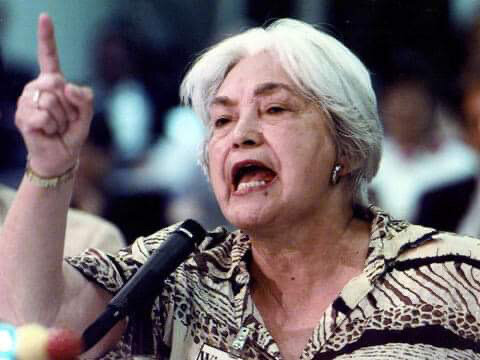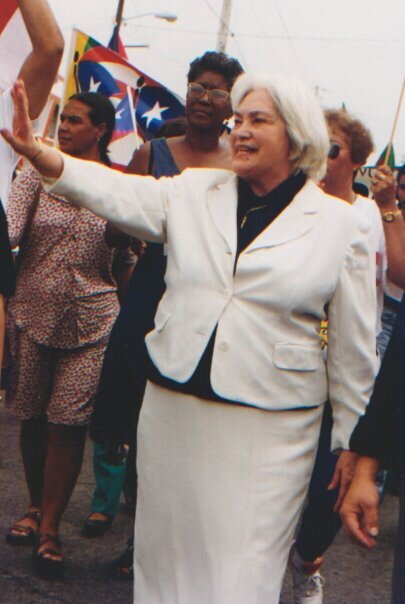
Puerto Rican Nationalist – Freedom Fighter
Born: November 19, 1919, Lares, Puerto Rico
Transitioned: August 1, 2010, San Juan, Puerto Rico
Lolita Lebrón (Dolores Lebrón Sotomayor) born in Lares, a small town of Puerto Rico known for its uprisings against Spanish colonialism. She grew up in poverty with her father being coffee plantation foreman and her mother staying at home to raise 5 children.

“No hay victoria sin dolor” -
Lolita Lebrón
“There is no victory without pain” - Lolita Lebrón

Lolita was a captivating young woman, having won first place in a beauty contest and crowned the Queen of the Flowers of May.
An icon of Puerto Rican nationalism, Lebrón became involved in the island’s Nationalist Party’s New York chapter in the early 1940s. This was after migrating from Puerto Rico in hopes of a better life where she began working as a seamstress at the age of 22. She served as secretary of the chapter and president of the Feminine Chapter of the Pro-Liberation Committee.

When Puerto Rico’s official status was changed to “Commonwealth” in 1952, the Nationalist Party began a series of revolutionary actions, including the Jayuya Uprising also known as the Jayuya Revolt or El Grito de Jayuya on October 30, 1950.
As part of this initiative, Lolita became the leader of a group of nationalists. Lebrón’s notorious journey began March 1, 1954, when she and three other Puerto Rican nationalists, Irving Flores Rodriguez, Rafael Cancel Miranda and Andres Figueroa Cordero, bought one-way train tickets from New York to Washington and entered the House of Representatives.”

“Ms. Lebrón was a stylishly dressed 34-year-old woman with the looks of the beauty queen she had been as a youth. She wore bright lipstick.
Firecrackers suddenly seemed to be exploding in the House chamber at 2:32 p.m., interrupting a debate about Mexican farm workers among the 243 representatives present. Congressmen dived and fell, though none were killed.
Piercing the confusion was the voice of Ms. Lebrón: “Viva Puerto Rico!” She emptied the chambers of a big Luger pistol, holding it in two hands and waving it wildly. She then threw down the pistol and whipped out a Puerto Rican flag, which she waved but never managed to unfurl fully. As she shouted, her companions trained their weapons on the House floor.

“My life I give for the freedom of my country,”
After she was arrested, the police found a note in her purse. “My life I give for the freedom of my country,” it read.
Although Ms. Lebrón fired eight shots, she was cleared of assault with intent to kill because she had fired at the ceiling. Nobody was killed, but five Congressman were wounded, one seriously.
All four shooters were later sentenced to an additional six years in another trial for seditious conspiracy.” Ms. Lebrón was convicted of five counts of assault with a dangerous weapon and sentenced to serve from 16 years and 8 months to 50 years in prison. Her colleagues, Rafael Cancel Miranda, Andres Figueroa Cordero and Irving Flores Rodriguez, were convicted on more serious counts and each sentenced to 25 to 75 years in prison.
– The New York Times “Lolita Lebrón, Puerto Rican Nationalist, Dies at 90” By Douglas Martin – Aug. 3, 2010

“I take responsibility for all,”
…read the note found in Lebrón’s pocketbook. “This is a cry for victory in our struggle for independence. My life I give for the freedom of my country.”
For her role in that protest for independence for Puerto Rico, Lebrón served almost 26 years at the Federal Reformatory for Women in Alderson, W.Va. While she was there, both of her children — a preteen son and a grown daughter — died.

Through it all she didn’t expect to live. She literally was willing to die to bring attention for the liberation of Puerto Rico.

She also didn’t allow a little time in jail stop her.
President Jimmy Carter granted them clemency in 1979 and in the same year along with Irvin Flores, Rafael Cancel Miranda and Oscar Collazo were recognized as the embodiment of the directive of their teacher Albizu Campos to exercise valor and sacrifice before representatives of fifty-one countries at the International Conference in Support of Independence for Puerto Rico, held in Mexico City.

''We don't want to forget the campaign is for Vieques and we need to have people united in this,'' Mrs. Lebrón said.
An incredible three-quarters of the island was appropriated in the 1940s and used by the U.S. Navy for bombing practice, war games, and dumping or burning old munitions. “Between 1940 and 2003, the Navy tested all manner of weapons on the eastern part of island, within a 900-acre Live Impact Area. Napalm, depleted uranium, TNT, and heavy metals were deployed in training exercises. In 1998 alone, 23,000 bombs were dropped on Vieques.”


“On June 26, 2001, Lebrón was among a group of protesters that were arrested for trespassing in the restricted area in Vieques. On July 19, 2001, she was sentenced to 60 days of prison on the charge that she was trespassing on Navy property. Lebrón had already served 23 days in jail since her June arrest, leaving her to serve 37 additional days. Less than two years after Lebrón's Vieques protest, on May 1, 2003, the U.S. Navy left Vieques and turned over its facilities to the government of Puerto Rico. Following this, she continued her participation in other pro independence activities.”
Source: Wikipedia


Lolita Lebrón transitioned on Sunday August 1, 2010 in San Juan, P.R. She was 90.
The cause was heart and lung failure.

Lolita Lebrón is buried at Santa María Magadalena de Pazzis Cemetery in Old San Juan.

''I can't see all of it in my life,'' she said. ''But I will see it because I believe in eternal life. I will see my people.'' -Lolita Lebrón

Who is Lolita Lebrón?
A video collage for your viewing pleasure.































































